Zoos and Aquariums Adapt to the Coronavirus
Published: May 6, 2020
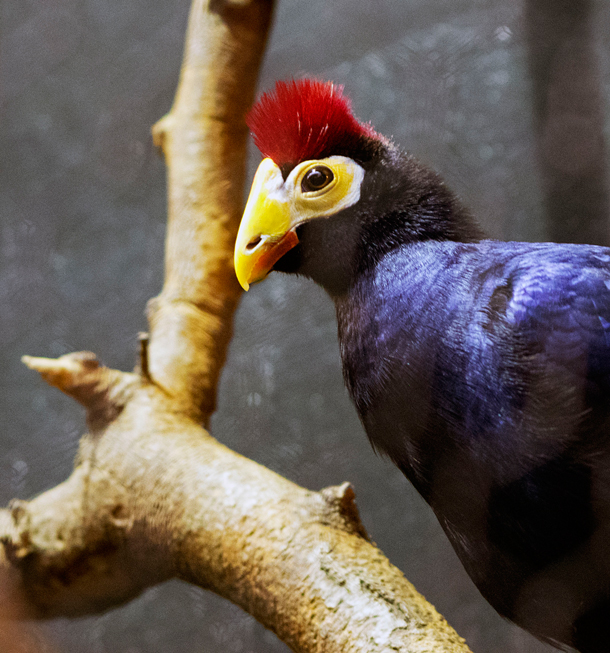
A fully-grown Lady Ross’ Turaco from the Cincinnati Zoo. (Photo: David Ellis, Flickr, CC BY-NC-ND 2.0)
(stream/download) as an MP3 file
With shelter-in-place orders affecting much of the country, zoos, aquariums, and wildlife centers have had to close their doors. Many of these facilities have gone online to continue their mission with virtual visits, exhibit livestreams, and enrichment programs. Aynsley O'Neill reports.
Also, across the country, animal care facilities are facing the question of how to care for their animals without visitor revenue during the coronavirus shutdown. Vikki Spruill, the President and CEO of the New England Aquarium in Boston, joins Host Steve Curwood to explain how her staff is taking care of more than 20,000 animals during the lockdown.
And Living on Earth's Explorer in Residence, Mark Seth Lender, witnesses an abundance of menhaden, and the creatures of the sea and air they help nourish.
CURWOOD: Hi, I’m Steve Curwood and today on the Living on Earth Podcast we’ll take a look at how zoos and aquariums are adapting to being shut down amid the coronavirus.
And we’ll have an essay about an important fish in the food chain of the Atlantic Ocean.
But first, your support helps make it possible to bring you this podcast, so please contribute what you can.
Five dollars or more makes a difference.
You can donate right now at LOE.org and thanks!
[THEME]
CURWOOD: Around the world, zoos, aquariums, and wildlife centers have had to close their doors to the public in an effort to slow the spread of the novel coronavirus. In a few minutes, we’ll talk with the CEO of the New England Aquarium, who is one of the many zoo and aquarium leaders and staff who are working hard to care and provide for their animals, without the support of visitor revenues. But thanks to the internet you can still visit zoos and aquariums, as many facilities have gone online engaging folks with glimpses behind the scenes of how animals are keeping busy without daily visitors. Living on Earth’s Aynsley O’Neill has more.
O’NEILL: Zoos, aquariums, and wildlife centers across the country are doing more than ever before to provide virtual content, both educational and entertaining, for would-be patrons everywhere.
The Cincinnati Zoo hosts a daily Home Safari aimed at children who are stuck at home. They can meet an animal, like the newborn Lady Ross’ turaco chick. At nearly two months old, the chick is starting to pick up some of her adult colorings, with metallic blue feathers peeking through her black fuzz.
HANDLER: By the way, so this turaco, unfortunately, her mother passed away. And the next day we discovered there was an egg in there. And the mother – we went to take the egg to put it in an incubator, and she started hatching right in one of the curator’s hands, Jenny’s hands. Some of her favorite items here are these soaked pear pellets that we’re feeding now. Little bits of banana here, and grape, and papaya. You’re looking right into the camera there? Here you go. Have some more.
O’NEILL: When the home safari is done, the Cincinnati zoo gives instructions for a relevant craft project. A fully-grown Lady Ross’ turaco has a crown of bright red feathers – so the kids are encouraged to use materials around the house to make a crown to match. The Los Angeles zoo takes arts and crafts to another level with an endangered species draw-along with Brian Kesinger, an illustrator for Walt Disney Studios. He takes his audience step-by-step through his process for drawing a California Condor.
KESINGER: You can see how much even I am observing the actual animal, even though I’ve drawn for, you know, a long time, almost 30 years. I’m still always going back and learning and looking at all these cool wrinkles around the mouth. So, I’m going to go ahead, and you can do this too. Add just a little, little line, kind of curving up that way, and then down this way. (31 seconds)
O’NEILL: Like the Condor, every animal Brian draws is one that the LA Zoo is helping to save from extinction. There’s also the Wildlife Images Rehabilitation and Education Center in Grant’s Pass, Oregon. They post behind-the-scenes updates, so anyone can read about the dramatic rescue of two great horned owl chicks, or watch as a recently rehabilitated squirrel is given her lunch.
CARETAKER: We’re going to bring the baby squirrel out here. She came in about ten days ago, and she’s still on formula. She gets fed three times a day.
[SQUIRREL EATING NOISES]
O’NEILL: And countless zoos and wildlife centers around the country are offering live camera feeds into the animal exhibits. So you can virtually visit the Smithsonian National Zoo to get your giant panda fix, or the Bronx Zoo to watch lemurs frolic. And at-home access isn’t just for land animals – sea creatures are getting plenty of attention as well. The Georgia Aquarium is posting its own live streams and educational programming. And they’re also holding storytime with children’s picture books, and virtual yoga sessions in front of their Ocean Voyager exhibit.
INSTRUCTOR: For everyone on this planet who’s going through something together, send out that intention. Cultivate that attitude. May all people everywhere be happy. May all people everywhere be healthy. May all people everywhere be filled with loving-kindness.
O’NEILL: And the New England Aquarium is hosting live question and answer sessions on their social media, as well as providing virtual experiences like watching a harbor seal get its teeth brushed – or even taking a dive inside the Giant Ocean Tank.
[GIANT OCEAN TANK NOISES]
O’NEILL: For Living on Earth, I’m Aynsley O’Neill.
CURWOOD: To find out what it’s like to manage a major public aquarium when it suddenly shuts down with no clear end in sight, we turn now to Vikki Spruill. She’s president and CEO of the New England Aquarium in Boston. Vicki, welcome to Living on Earth!
SPRUILL: Hi, Steve, it's great to be here.
CURWOOD: First of all, where are you right now? And how are you dealing with social distancing?
SPRUILL: Well I, like millions of other Americans, am sitting in a makeshift home office in a suburb of Boston, Massachusetts, where I live.
CURWOOD: That's not your favorite place to be right now running an aquarium, I imagine.
SPRUILL: No, my favorite place would be to be downtown and to sneak over to the main building of our aquarium and stand there and watch all the kids with their noses to the glass, admiring our 20,000 animals. That's what I wish I was doing.
CURWOOD: 20,000 creatures.
SPRUILL: Yeah.
CURWOOD: And ranging in size from?
SPRUILL: Oh, itty bitty little fishes all the way up to our grande dame, Myrtle the turtle.

The entrance to the New England Aquarium on a summer day in 2017. With the current lockdown, no visitors have been to the aquarium since mid-March. (Photo: Wikimedia Commons, CC BY-SA 4.0)
CURWOOD: So, with the aquarium closed during this pandemic crisis, how are the animals?
SPRUILL: So the animals are being cared for by an amazing team of aquarists and our animal care team. We have about 30 staff in the building now. They are considered essential personnel. And they go in there every day and continue to train and feed and take care of the medical needs of our wonderful animals. We're a little bit unusual as compared to other cultural institutions and museums in that when we close our doors, we still have to take care of the animals. And so, it's been quite challenging to figure it all out. But I'm also just deeply, deeply grateful, and impressed with the team that's pulled this together.
CURWOOD: You've been posting some virtual visits from the aquarium, letting anyone who wants to spend some time in the company of your outfit from the safety of quarantine. How is it trying to transition to physical experiences, such as petting a stingray or feeling the splash of water as a little turtle swims by in some of those tables you have? How do you change that into a virtual experience?
SPRUILL: Well, it's funny when we closed, our members and our visitors, were asking the same question you asked, which is how are the animals, and we knew it would be important to keep that experience alive for them. And because we have staff there, already caring for the animals, we knew we could take that experience to them directly. So, we began to videotape and use our phones to share the everyday experiences that happen behind the scenes, as our staff is caring for the animals. And I, I don't think any of us expected to have the kind of reaction we've had. People have just loved it. And we locked into a regular slot every morning at 11 am. And, and then in the afternoon, we're creating an educational opportunity for kids that links back to what they saw that morning. And the numbers are through the roof in terms of followers and people who are signing up and watching every day, it's so heartening.
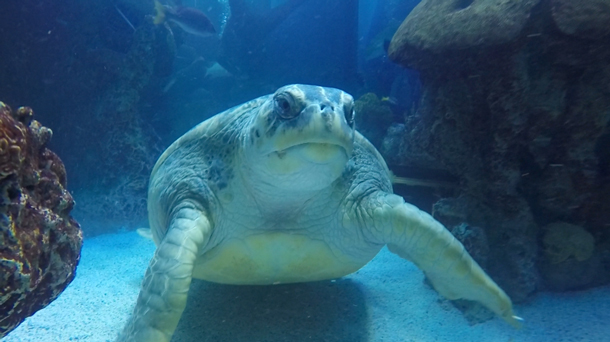
Myrtle the Turtle, a giant green turtle who resides in the New England Aquarium’s Giant Ocean Tank. (Photo: Courtesy of New England Aquarium)
CURWOOD: Now, which are the animals, by the way, have noticed that they maybe are being streamed and are looking maybe for further acting roles.
SPRUILL: So, of course, there's Myrtle the turtle. She's been with us since almost the beginning of the aquarium, 50 years ago. And we're not quite sure how old she is, but we put her close to 90, and she rules the roost and still does, loving the camera and loving the attention.
CURWOOD: What are you missing the most from the aquarium right now? Is it those penguins waddling in the front? Is it the smell of fresh fish? What's going on?
SPRUILL: I think I miss the visitors. I miss the animals, but I see them through our virtual programming. I know they're being well taken care of. I miss our visitors because that's the lifeblood of our institution. And, you know, 80% of our revenue is derived from our special events and from the visitors who come through the door. And so, it's a sobering moment when one's revenue source is completely shut down. And that's what's happening to us and to so many other businesses. And you know, typically if a crisis happens in one part of the country, say a storm or a hurricane or something, we're a very tight-knit network of institutions who help one another with taking the animals if we have a particular challenge and whatnot. This is a little different because we're all in the same boat. And I think that's why it's so important for all of us to be able to have the resources to continue to shelter our animals in place and take care of them.
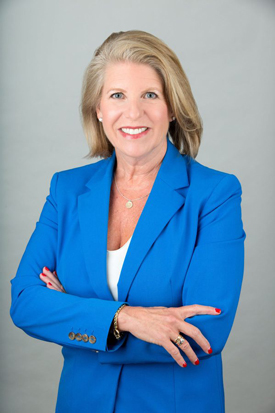
Vikki Spruill is the President and CEO of the New England Aquarium. (Photo: Courtesy of New England Aquarium)
CURWOOD: So, it's been a very tough time. Tell me about a moment where it wasn't so tough. It was, in fact, maybe wonderful.
SPRUILL: That moment has to be when I went into the building after we'd closed, I went to thank our staff who are there, taking care of the animals. I was walking around the Giant Ocean Tank and Myrtle, our giant green turtle came and I swear she was looking at me. And I asked our Vice President for Animal Care who was with me if she thought the animals missed the people. And she said I think they might because they're so used to the human interaction that they have. And it was such a lovely moment to realize that this interaction between me and this, you know, an amazing turtle that we've cared for all these years, it was a connection. And it just made me realize and remember why I do what I do and why that beloved institution exists.
CURWOOD: Vikki Spruill is the CEO and President of the New England Aquarium. Vikki, thank you so much for taking the time with us today.
SPRUILL: Thank you, Steve.
CURWOOD: For links to the online tours and events hosted by the New England Aquarium and the institutions Aynsley mentioned earlier visit the living on earth website, loe.org.
[MUSIC: Blue Dot Sessions, "Rue Severine", The Sweet Hots]
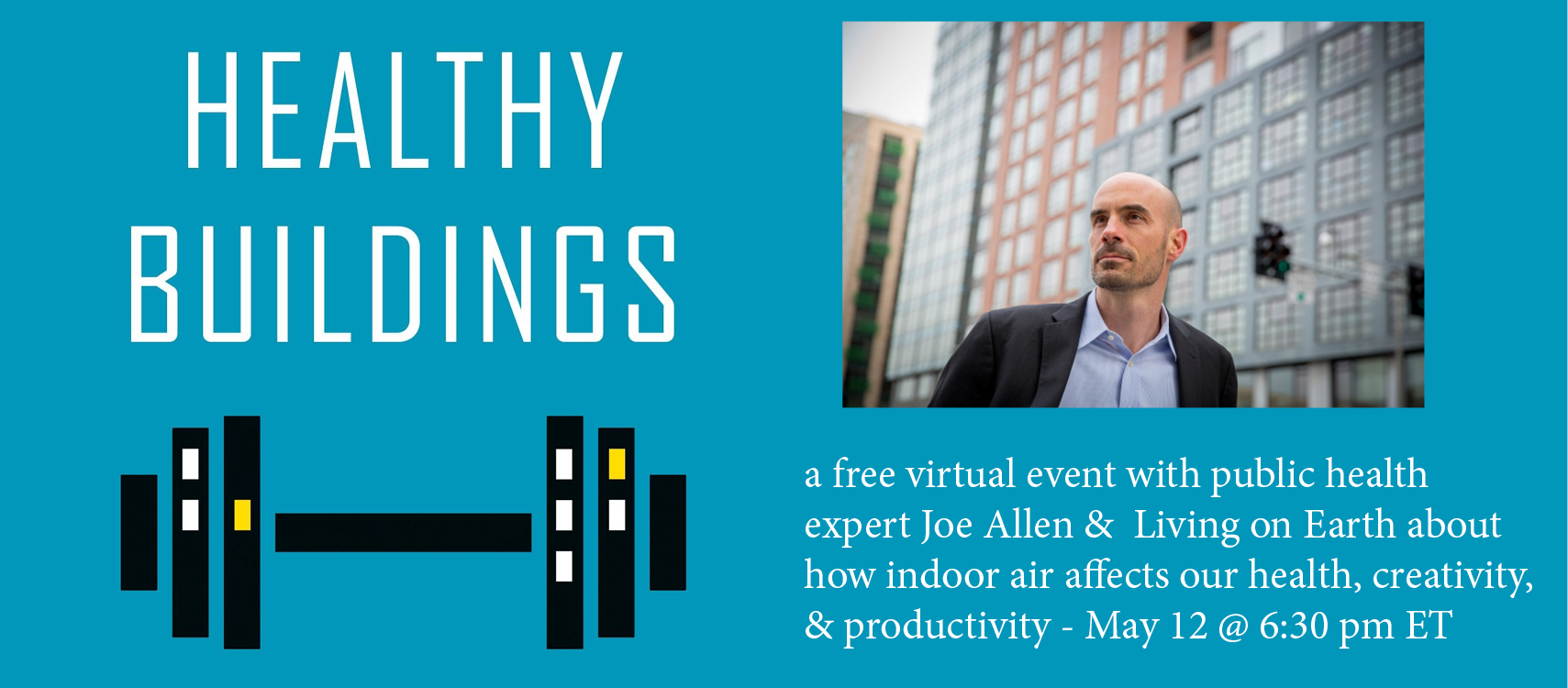
CURWOOD: We are spending a lot of time indoors these days.
And indoor air can affect our health, creativity, and productivity
For some insight we will be hosting a free live streamed conversation with renowned Harvard public health expert Joe Allen.
He’ll be talking about his new book, Healthy Buildings and exploring how we can design indoor spaces to maximize our well-being.
The event is May 12 at 6:30pm Eastern.
Learn more about this and other events in our Good Reads on Earth series at the Living on Earth website, loe.org/events.
[MUSIC: Blue Dot Sessions, "Rue Severine", The Sweet Hots]

A Great Egret amidst an abundance of menhaden. (Photo: (c) Mark Seth Lender)
CURWOOD: Well, it may be the large charismatic animals that draw in the crowds at aquariums, but for Living on Earth’s Explorer in Residence, Mark Seth Lender, the real show is much lower down on the food chain.
The Farmer The Grain The Miller The Sea
Menhaden, Striped Bass & Seabirds
Long Island Sound
© 2020 Mark Seth Lender
All Rights Reserved
LENDER: Menhaden are farming the sea. They plough with their fins shuttling to and fro, and plant among currents known only to them among fields furrowed in waves. And never know if the seed sprouts, or not. And never know the fruit of their labor.
On the tide their plantings drift as if in a calm before storm. Towards shore, then into the rivers: the Neck, the Housatonic, the Thames, the Connecticut and all the tributaries there whose names have been lost to us. The Namers of these freshets and rivulets also long gone.
Everything, changed.
And of the seed? In spite of the wear and erosions of time? Nourished under a cold sun will they find a lighted way?
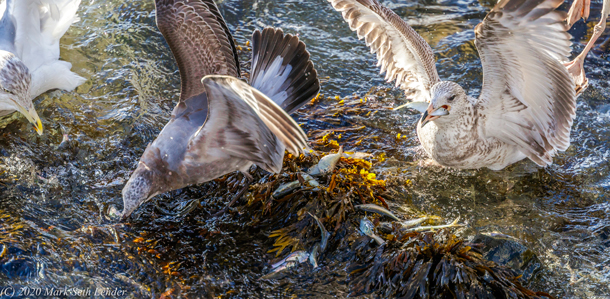
Gulls feast on the little fish. (Photo: (c) Mark Seth Lender)
The months come.
The months go.
The seasons pass.
Autumnal Equinox and the seed heads have ripened to bursting. Young menhaden cloud the shallows with their silvering thick as grain, churning and turning calling forth, though it is against their will, the Harvest:
And from below striped bass, Threshers of the Ocean; and from above the gulls, Reapers of the Air; and along and along paddling and dab-diving double-crested cormorants who are the Gleaners; all come to do their workings. Mouths and teeth and beaks and bills winnowing flesh from water and the little fishes driven in upon the rocky shore to meet in a terrible convergence there tangled in sea weed. As the gulls plunge and scream. The stripers stream, round, and round, and leaping! Double-crested cormorants trim and swimming in a great wedge.
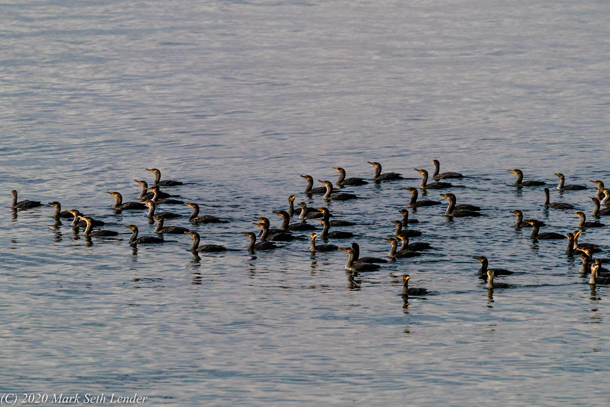
Double-crested cormorants. (Photo: (c) Mark Seth Lender)
V for Victory.
For them!
And for the little fishes, now the Miller comes.
White on white on a field of wet dusky blue, his wings wind-milling, his yellow beak as pallid as the sun. Here, he descends. There, he lands, stilting on a lead of boulders pointing out into the bight. He waits. Patient. Steady. Great Egret all in his elegance! And his long neck plunges to part the surface into a spray, pearls and diamonds of light and water, and lifts five live and struggling: too many to swallow too much to let go he can hardly bear it!
- When -
Rising bursting swimming airborne behind and about Great Egret all for a breathless instant all Brother and Sister Menhaden leap! At once! A turmoil! That cannot be counted!
- Then -
Tumble splunging splashing…
While from the Miller's mouth, others fall to greet them, and the wetted stones receive them.
Great Egret in the end swallows just one, overcome, by the richness, of the grain, that grows only in the sea.
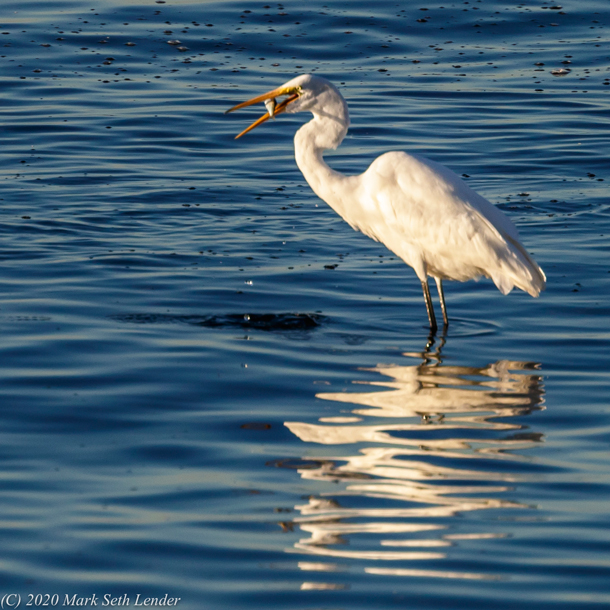
In the end the Great Egret swallows just one menhaden. (Photo: (c) Mark Seth Lender)
CURWOOD: That’s Living on Earth’s Explorer in Residence, Mark Seth Lender.
[MUSIC: Blue Dot Sessions, "Cymbal Patter", Warmbody]
CURWOOD: Living on Earth is produced by the World Media Foundation.
Our crew includes Naomi Arenberg, Paloma Beltran, Bobby Bascomb, Thurston Briscoe, Jenni Doering, Jay Feinstein, Merlin Haxhiymeri, Candice Siyun Ji, Don Lyman, Isaac Merson, Aynsley O’Neill, Jake Rego, and Jolanda Omari.
Tom Tiger engineered our show.
Alison Lirish Dean composed our themes.
You can hear us anytime at L-O-E dot org, Apple Podcasts and Google Podcasts- and like us, please, on our Facebook page - Living on Earth.
We tweet from @livingonearth. And find us on Instagram at livingonearthradio. I’m Steve Curwood.
Thanks for listening!
ANNOUNCER: Support for Living on Earth comes from Sailors for the Sea and Oceana. Helping boaters race clean, sail green, and protect the seas they love. More information at sailors for the sea dot org.
ANNOUNCER 2: PRX.
Links
More from the New England Aquarium
More from the Cincinnati Zoo & Botanical Garden
More from the Los Angeles Zoo & Botanical Gardens
More from the Wildlife Images Rehabilitation and Education Center
More from the Georgia Aquarium
Read the field note for "The Farmer The Grain The Miller The Sea"
Living on Earth wants to hear from you!
Living on Earth
62 Calef Highway, Suite 212
Lee, NH 03861
Telephone: 617-287-4121
E-mail: comments@loe.org
Newsletter [Click here]
Donate to Living on Earth!
Living on Earth is an independent media program and relies entirely on contributions from listeners and institutions supporting public service. Please donate now to preserve an independent environmental voice.
NewsletterLiving on Earth offers a weekly delivery of the show's rundown to your mailbox. Sign up for our newsletter today!
 Sailors For The Sea: Be the change you want to sea.
Sailors For The Sea: Be the change you want to sea.
 The Grantham Foundation for the Protection of the Environment: Committed to protecting and improving the health of the global environment.
The Grantham Foundation for the Protection of the Environment: Committed to protecting and improving the health of the global environment.
 Contribute to Living on Earth and receive, as our gift to you, an archival print of one of Mark Seth Lender's extraordinary wildlife photographs. Follow the link to see Mark's current collection of photographs.
Contribute to Living on Earth and receive, as our gift to you, an archival print of one of Mark Seth Lender's extraordinary wildlife photographs. Follow the link to see Mark's current collection of photographs.
 Buy a signed copy of Mark Seth Lender's book Smeagull the Seagull & support Living on Earth
Buy a signed copy of Mark Seth Lender's book Smeagull the Seagull & support Living on Earth

